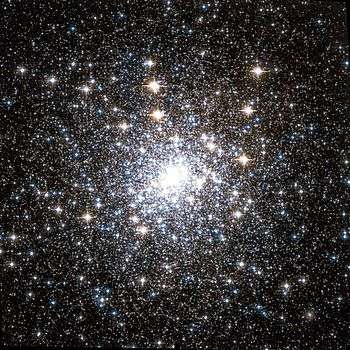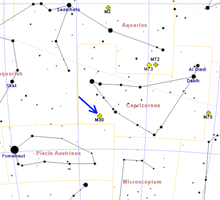Messier 30
| Messier 30 | |
|---|---|
 | |
| Observation data (J2000 epoch) | |
| Class | V[1] |
| Constellation | Capricornus |
| Right ascension | 21h 40m 22.12s[2] |
| Declination | –23° 10′ 47.5″[2] |
| Distance | 27.14 ± 0.65 kly (8.3 ± 0.20 kpc)[3][4] |
| Apparent magnitude (V) | +7.7[5] |
| Apparent dimensions (V) | 12'.0 |
| Physical characteristics | |
| Mass | 1.6×105[6] M☉ |
| Metallicity | = –2.27[7] dex |
| Estimated age | 12.93 Gyr[8] |
| Other designations | M30, NGC 7099, GCl 122[5] |
Messier 30 (also known as M30 or NGC 7099) is a globular cluster of stars in the southern constellation of Capricornus. It was discovered by the French astronomer Charles Messier in 1764, who described it as a circular nebula without a star. In the New General Catalogue, compiled during the 1880s, it was described as a "remarkable globular, bright, large, slightly oval." This cluster can be easily viewed with a pair of 10×50 binoculars,[9] forming a patch of hazy light some 4 arcminutes wide that is slightly elongated along the east–west axis.[9] With a larger instrument, individual stars can be resolved and the cluster will cover an angle of up to 12 arcminutes across with a compressed core one arcminute wide.[10] It is best observed around August.[9]
M30 is located at a distance of about 27,100 light-years from Earth,[4] and is about 93 light-years across.[10] The estimated age is roughly 12.93 billion years[8] and it has a combined mass of about 160,000 times the mass of the Sun.[6] The cluster is following a retrograde orbit through the inner galactic halo, suggesting that it was acquired from a satellite galaxy rather than forming within the Milky Way.[8] It is currently located at a distance of about 22.2 kly (6.8 kpc) from the center of the galaxy, compared to an estimated 26 kly (8.0 kpc) for the Sun.[11]
The M30 cluster has passed through a dynamic process called core collapse and now has a concentration of mass at its core of about a million times the Sun's mass per cubic parsec. This makes it one of the highest density regions in the Milky Way galaxy. Stars in such close proximity will experience a high rate of interactions that can create binary star systems, as well as a type of star called a blue straggler that is formed by mass transfer.[3] A process of mass segregation may have caused the central region to gain a greater proportion of higher mass stars, creating a color gradient with increasing blueness toward the middle of the cluster.[12]
References
- ↑ Shapley, Harlow; Sawyer, Helen B. (August 1927), "A Classification of Globular Clusters", Harvard College Observatory Bulletin, 849 (849): 11–14, Bibcode:1927BHarO.849...11S.
- 1 2 Goldsbury, Ryan; et al. (December 2010), "The ACS Survey of Galactic Globular Clusters. X. New Determinations of Centers for 65 Clusters", The Astronomical Journal, 140 (6): 1830–1837, arXiv:1008.2755, Bibcode:2010AJ....140.1830G, doi:10.1088/0004-6256/140/6/1830.
- 1 2 Lugger, Phyllis M.; et al. (March 2007), "Chandra X-Ray Sources in the Collapsed-Core Globular Cluster M30 (NGC 7099)", The Astrophysical Journal, 657 (1): 286–301, arXiv:astro-ph/0606382, Bibcode:2007ApJ...657..286L, doi:10.1086/507572
- 1 2 Kains, N.; et al. (July 2013), "Estimating the parameters of globular cluster M 30 (NGC 7099) from time-series photometry", Astronomy and Astrophysics, 555 (1): 36–50, arXiv:1305.3606, Bibcode:2013A&A...555A..36K, doi:10.1051/0004-6361/201321819
- 1 2 "M 30". SIMBAD. Centre de données astronomiques de Strasbourg. Retrieved 2006-11-16.
- 1 2 Vande Putte, D.; Cropper, Mark (January 2009), "Detecting the effect of globular cluster impacts on the disc of the Milky Way", Monthly Notices of the Royal Astronomical Society, 392 (1): 113–124, arXiv:0811.3106, Bibcode:2009MNRAS.392..113V, doi:10.1111/j.1365-2966.2008.14072.x
- ↑ Boyles, J.; et al. (November 2011), "Young Radio Pulsars in Galactic Globular Clusters", The Astrophysical Journal, 742 (1): 51, arXiv:1108.4402, Bibcode:2011ApJ...742...51B, doi:10.1088/0004-637X/742/1/51.
- 1 2 3 Forbes, Duncan A.; Bridges, Terry (May 2010), "Accreted versus in situ Milky Way globular clusters", Monthly Notices of the Royal Astronomical Society, 404 (3): 1203–1214, arXiv:1001.4289, Bibcode:2010MNRAS.404.1203F, doi:10.1111/j.1365-2966.2010.16373.x
- 1 2 3 Bone, N. M. (August 2008), "Sky notes, 2008 August & September", Journal of the British Astronomical Association, 118 (4): 231–232, Bibcode:2008JBAA..118..231B
- 1 2 O'Meara, Stephen James (1998), The Messier objects, Deep-sky companions, Cambridge University Press, p. 108, ISBN 0-521-55332-6
- ↑ Dinescu, Dana I.; et al. (January 1999), "Space Velocities of Southern Globular Clusters. II. New Results for 10 Clusters", The Astronomical Journal, 117 (1): 277–285, Bibcode:1999AJ....117..277D, doi:10.1086/300699
- ↑ Howell, Justin H.; Guhathakurta, Puragra; Tan, Amy (March 2000), "Radial Color Gradient and Main-Sequence Mass Segregation in M30 (NGC 7099)", The Astronomical Journal, 119 (3): 1259–1267, arXiv:astro-ph/9912002, Bibcode:2000AJ....119.1259H, doi:10.1086/301270

External links
| Wikimedia Commons has media related to Messier 30. |
- Globular Cluster M30 @ SEDS Messier pages
- Messier 30, Galactic Globular Clusters Database page
- Gray, Meghan. "M30 – Globular Cluster". Deep Sky Videos. Brady Haran.
- Messier 30 on WikiSky: DSS2, SDSS, GALEX, IRAS, Hydrogen α, X-Ray, Astrophoto, Sky Map, Articles and images
